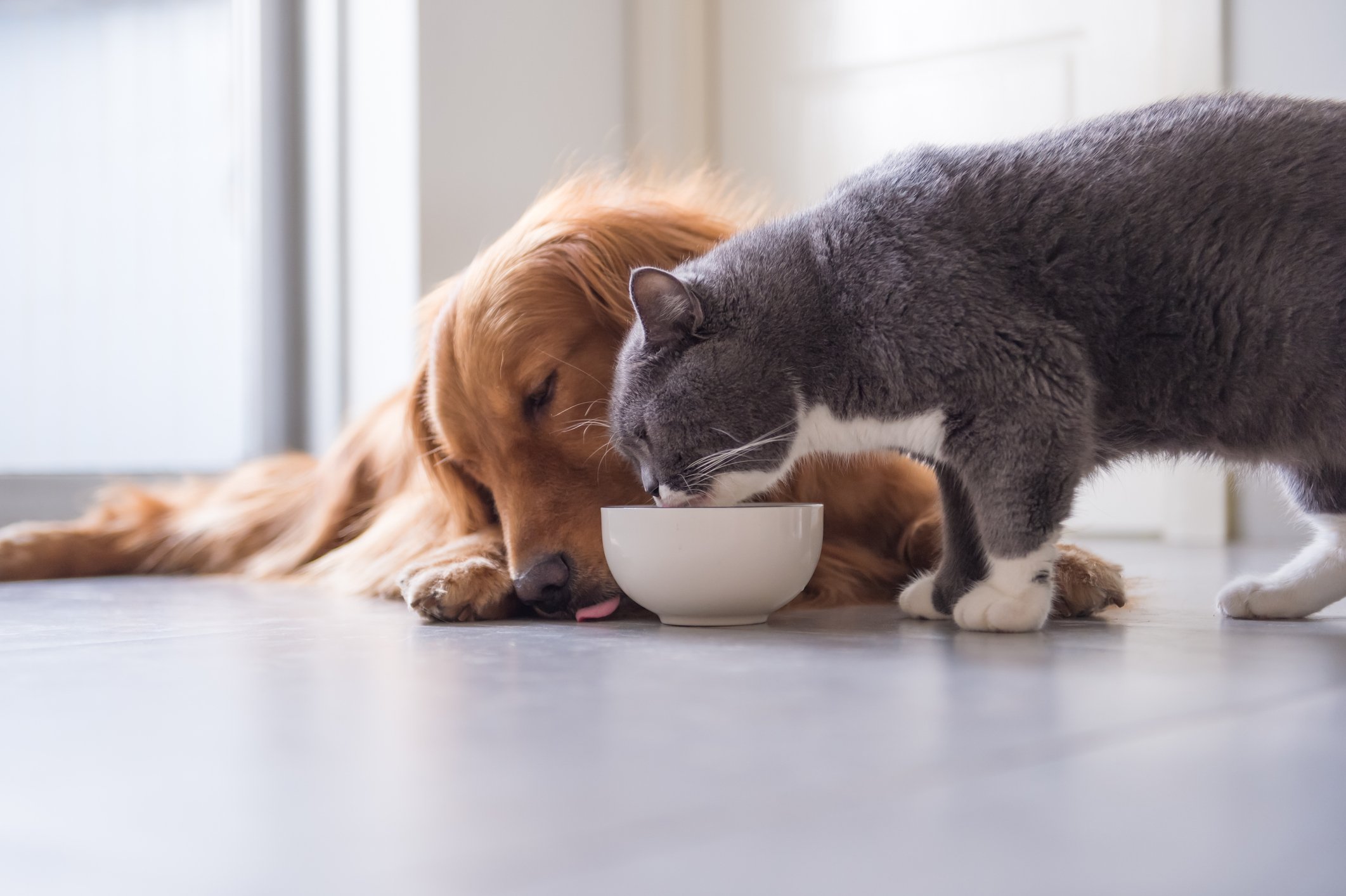Pet Caloric Needs
-
Check the label on your pet's food to determine the calorie content per serving.
Calculating the calorie count in your pet’s food and treats is important in knowing how much to feed to maintain your pet’s optimal weight and health.
Check the label - Pet food and treat products are required to have a nutritional label that contains calories or “KCals,” the abbreviation for “kilocalories.” These terms are often used interchangeably.
Pet food formulations can vary widely in serving size, caloric density, ingredients, nutritional content, and formulation (wet versus dry). The amount of protein, fat, fiber, and nutrients also influences the serving size.
Treats Count - Treats should make up no more than 10% of a pet’s daily calories. Treats do not have to be nutritionally balanced like commercial pet foods.
Opt for low-calorie, healthy treats that have nutritional value and are made with high-quality ingredients.
-
This is the amount of energy your pet needs to maintain its ideal weight or healthy body condition.
Your individual pet’s nutritional and daily caloric needs are based on several factors, including age, size, activity level, health status, medical needs, and body condition.
Most pet food companies provide user-friendly pet food calculator on their websites to help determine how much to feed a pet daily.
Your pet’s veterinary healthcare team is the most valuable resource for helping establish correct feeding guidelines and a diet that meets your pet’s needs. They can calculate your pet's Resting Energy Requirements (RER) (the amount of energy your pet needs to maintain essential bodily functions) and their Daily Energy Requirements (DER).
Basic Calorie Calculation for Energy Needs of Dogs and Cats
This calculation is intended for use by veterinary healthcare professionals for dogs and cats
This Resting Energy Requirement (RER) formula is intended to estimate the number of calories needed for a pet to perform vital bodily functions, including breathing, digestion, circulation, organ function, etc. The RER is a very basic estimate of a pet’s total daily energy needs and is a starting point for estimating how many calories or food a pet requires each day. A pet’s individual needs can vary widely.
RER in kcal/day =
(ideal or target weight in kg ^ 0.75) x 70
or (ideal or target weight in kg) to the 3⁄4 power) x 70
alternate calculation:
30 x (body weight in kilograms) + 70
Attaining and maintaining a healthy body condition and weight is based on providing an appropriate energy balance and meeting all nutritional needs of the dog or cat. Healthy nutrition depends on several additional factors such as life stage, genetics, spay/neuter status, existing medical conditions, use of medications, the quality and composition of food, etc. This is why any weight loss program should only be done under the supervision of a veterinary healthcare team.
Let’s take a look at some common daily caloric averages for dogs and cats.
Approximate Daily Caloric Needs for Average Indoor Pets
| Cats | |
| 10 lbs. | 180 to 200 calories |
| Dogs | |
| 10 lbs. | 200 to 275 calories |
| 20 lbs. | 325 to 400 calories |
| 50 lbs. | 700 to 900 calories |
| 70 lbs. | 900 to 1050 calories |
| 90 lbs. | 1100 to 1350 calories |
Daily Caloric Needs for Active Humans
| Male | 2500 Calories |
| Female | 2000 Calories |
|
CALORIE CHART |
||||
|
Typical Total Daily Calories to achieve Weight Loss |
Lightly Active Indoor Spayed or Neutered Dog Maintenance Diet
|
|||
|
Ideal or Target Weight |
RER to Feed for Weight Loss |
80% RER |
70% RER |
|
|
5 |
138 |
111 |
97 |
166 |
|
6 |
152 |
121 |
106 |
182 |
|
7 |
165 |
132 |
116 |
199 |
|
8 |
179 |
143 |
125 |
215 |
|
9 |
193 |
154 |
135 |
231 |
|
10 |
206 |
165 |
144 |
248 |
|
11 |
220 |
176 |
154 |
264 |
|
12 |
234 |
187 |
164 |
280 |
|
13 |
247 |
198 |
173 |
297 |
|
14 |
261 |
209 |
183 |
313 |
|
15 |
275 |
220 |
192 |
329 |
|
16 |
288 |
231 |
202 |
346 |
|
17 |
302 |
241 |
211 |
362 |
|
18 |
315 |
252 |
221 |
379 |
|
19 |
329 |
263 |
230 |
395 |
|
20 |
343 |
274 |
240 |
411 |
|
21 |
356 |
285 |
249 |
428 |
|
22 |
370 |
296 |
259 |
444 |
|
23 |
384 |
307 |
269 |
460 |
|
24 |
397 |
318 |
278 |
477 |
|
25 |
411 |
329 |
288 |
493 |
|
26 |
425 |
340 |
297 |
509 |
|
27 |
438 |
351 |
307 |
526 |
|
28 |
452 |
361 |
316 |
542 |
|
29 |
465 |
372 |
326 |
559 |
|
30 |
479 |
383 |
335 |
575 |
|
31 |
493 |
394 |
345 |
591 |
|
32 |
506 |
405 |
354 |
608 |
|
33 |
520 |
416 |
364 |
624 |
|
34 |
534 |
427 |
374 |
640 |
|
35 |
547 |
438 |
383 |
657 |
|
36 |
561 |
449 |
393 |
673 |
|
37 |
575 |
460 |
402 |
689 |
|
38 |
588 |
471 |
412 |
706 |
|
39 |
602 |
481 |
421 |
722 |
|
40 |
615 |
492 |
431 |
739 |
|
41 |
629 |
503 |
440 |
755 |
|
42 |
643 |
514 |
450 |
771 |
|
43 |
656 |
525 |
459 |
788 |
|
44 |
670 |
536 |
469 |
804 |
|
45 |
684 |
547 |
479 |
820 |
|
46 |
697 |
558 |
488 |
837 |
|
47 |
711 |
569 |
498 |
853 |
|
48 |
725 |
580 |
507 |
869 |
|
49 |
738 |
591 |
517 |
886 |
|
50 |
752 |
601 |
526 |
902 |
|
51 |
765 |
612 |
536 |
919 |
|
52 |
779 |
623 |
545 |
935 |
|
53 |
793 |
634 |
555 |
951 |
|
54 |
806 |
645 |
564 |
968 |
|
55 |
820 |
656 |
574 |
984 |
|
56 |
834 |
667 |
584 |
1000 |
|
57 |
847 |
678 |
593 |
1017 |
|
58 |
861 |
689 |
603 |
1033 |
|
59 |
875 |
700 |
612 |
1049 |
|
60 |
888 |
711 |
622 |
1066 |
|
62 |
915 |
732 |
641 |
1099 |
|
64 |
943 |
754 |
660 |
1131 |
|
66 |
970 |
776 |
679 |
1164 |
|
68 |
997 |
798 |
698 |
1197 |
|
70 |
1025 |
820 |
717 |
1229 |
|
72 |
1052 |
841 |
736 |
1262 |
|
74 |
1079 |
863 |
755 |
1295 |
|
76 |
1106 |
885 |
774 |
1328 |
|
78 |
1134 |
907 |
794 |
1360 |
|
80 |
1161 |
929 |
813 |
1393 |
|
85 |
1229 |
983 |
860 |
1475 |
|
90 |
1297 |
1038 |
908 |
1557 |
|
95 |
1365 |
1092 |
956 |
1639 |
|
100 |
1434 |
1147 |
1004 |
1720 |
|
105 |
1502 |
1201 |
1051 |
1802 |
|
110 |
1570 |
1256 |
1099 |
1884 |
|
115 |
1638 |
1311 |
1147 |
1966 |
|
120 |
1706 |
1365 |
1194 |
2048 |

General Guidelines for Pet Weight Loss
Based on a pet’s degree of excess body fat, it is often recommended to use a target weight higher than the ideal or goal weight when starting a weight loss program. We strongly advise pet owners not to reduce feeding below RER calories unless under direct supervision by their veterinary healthcare provider.
General guidelines for safe weight loss in dogs are 1-5% body weight loss per month (3-5% in many cases). For cats, about one-half pound (0.25 kg) per month, or 1 to 3% of their current body weight.
In cases that fail to respond to this number of calories, the total may need to be reduced, or an alternative therapeutic weight loss diet may be tested.
For weight loss in dogs, feeding the calculated RER calories for a weight loss target weight (or ideal weight in some cases) should be adequate.
For weight loss in cats, multiply the RER of the target or ideal weight by 0.8 (80% RER).
IMPORTANT NOTE: If the pet does not achieve desired or expected weight loss within 90 days, change the number of daily calories being fed, pet food brand, increase protein and fiber, change therapeutic weight loss diet formulation, reevaluate for an underlying medical condition, or implement other changes under veterinary supervision.
